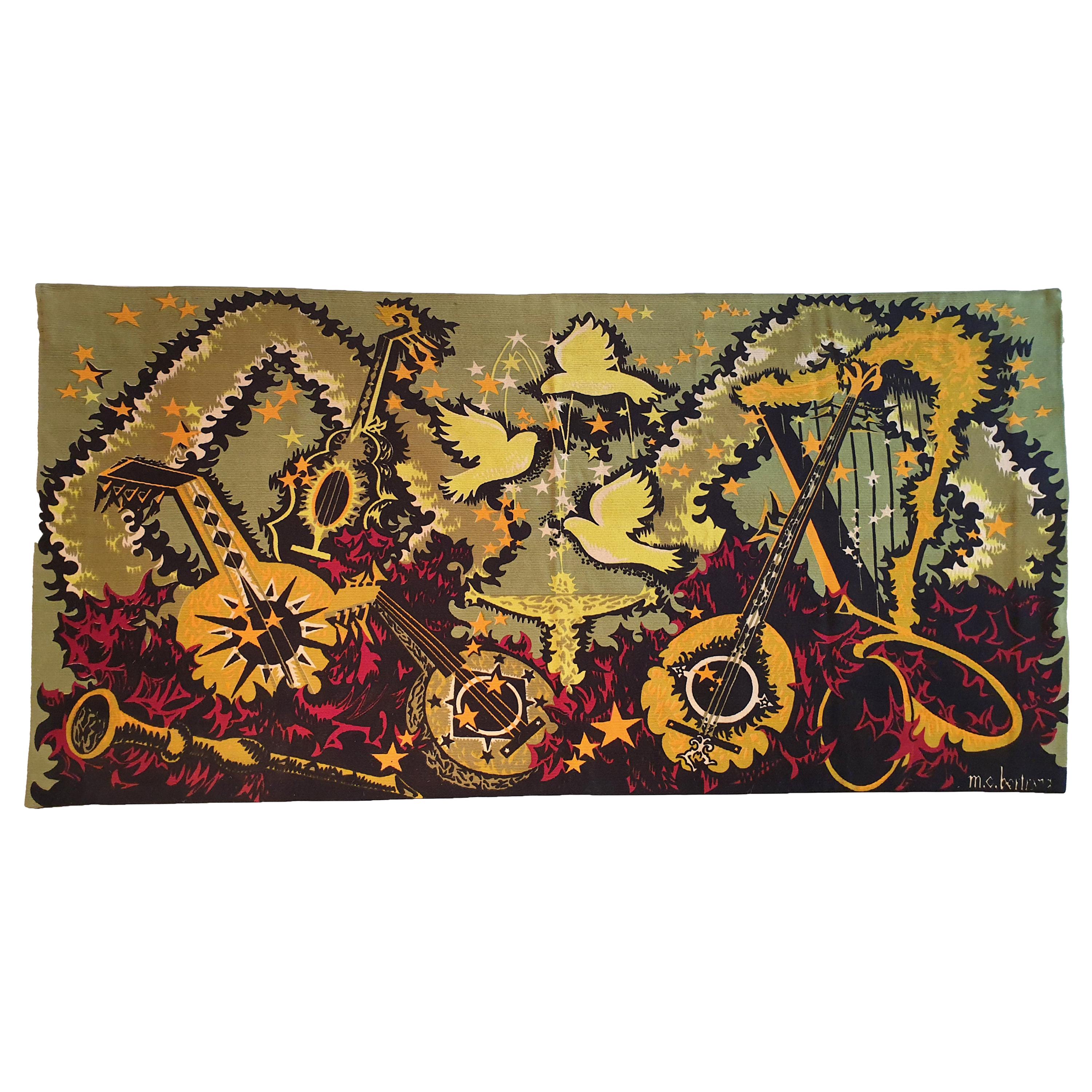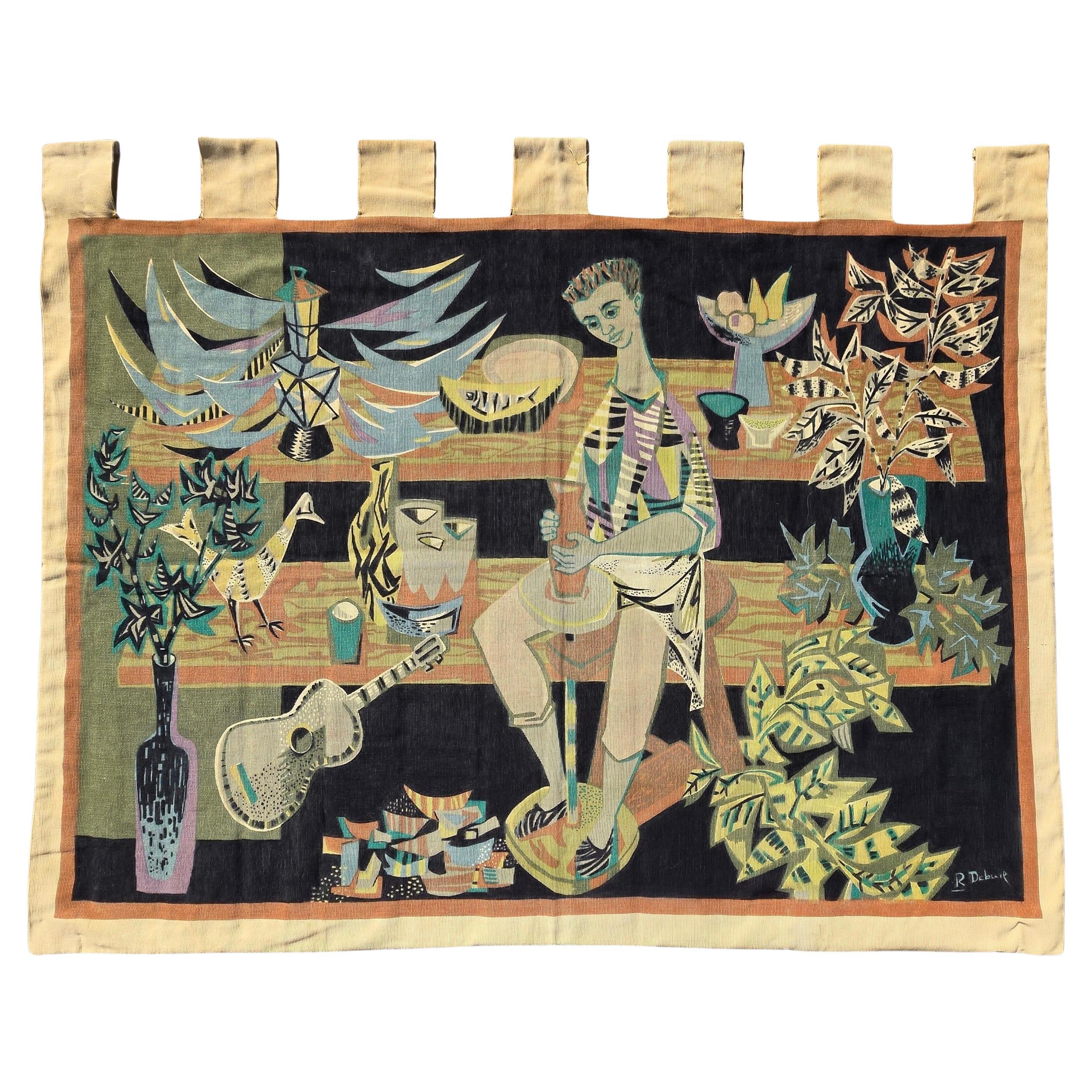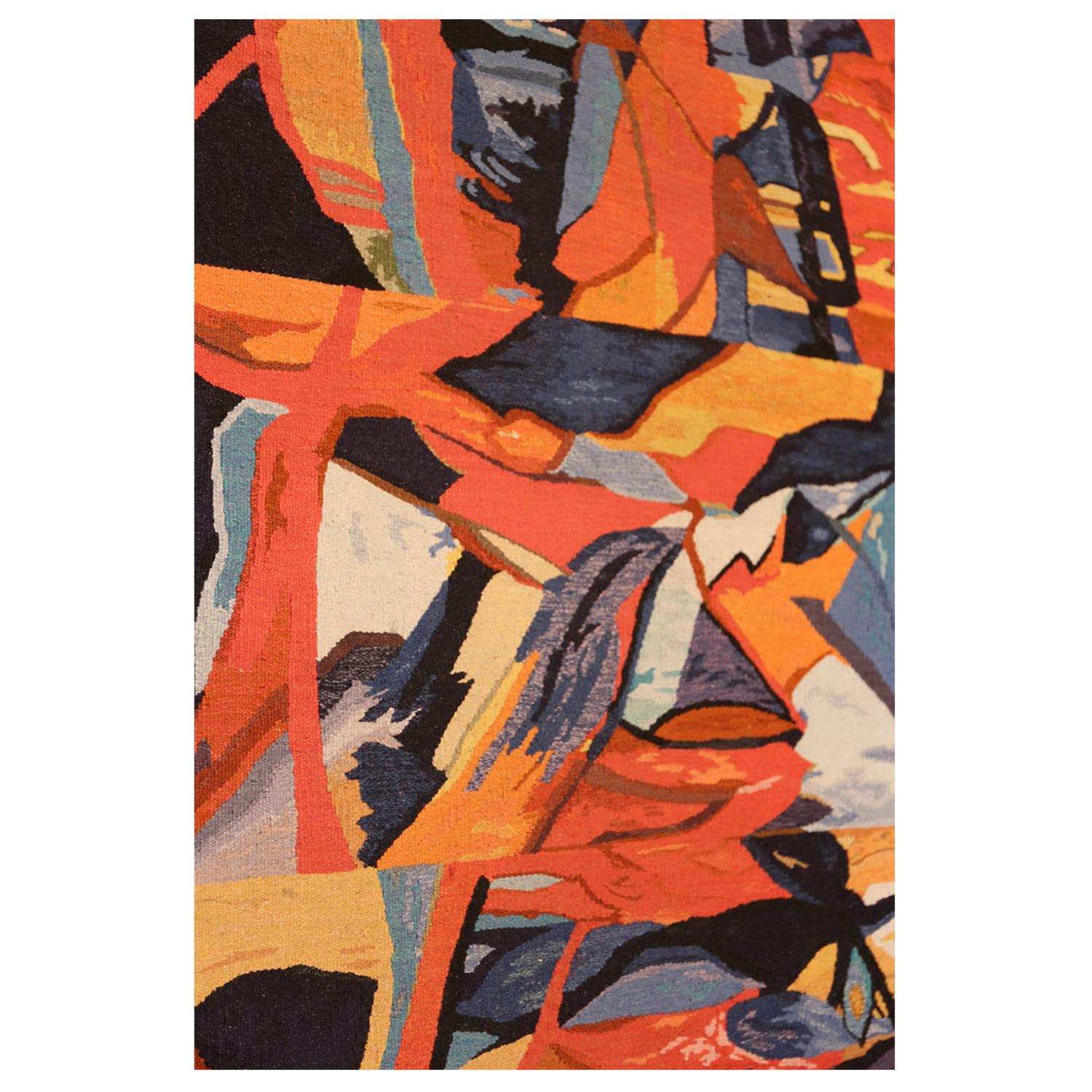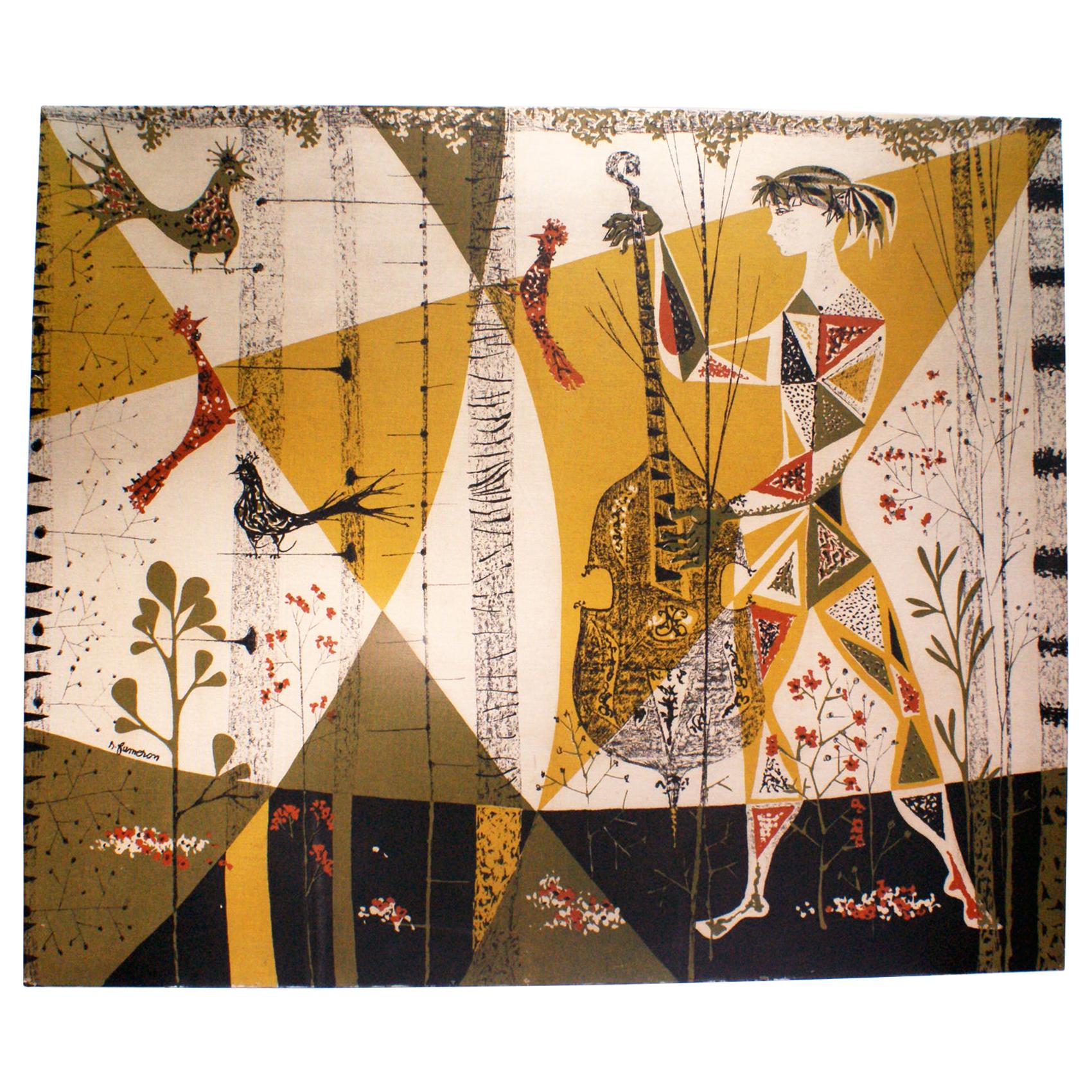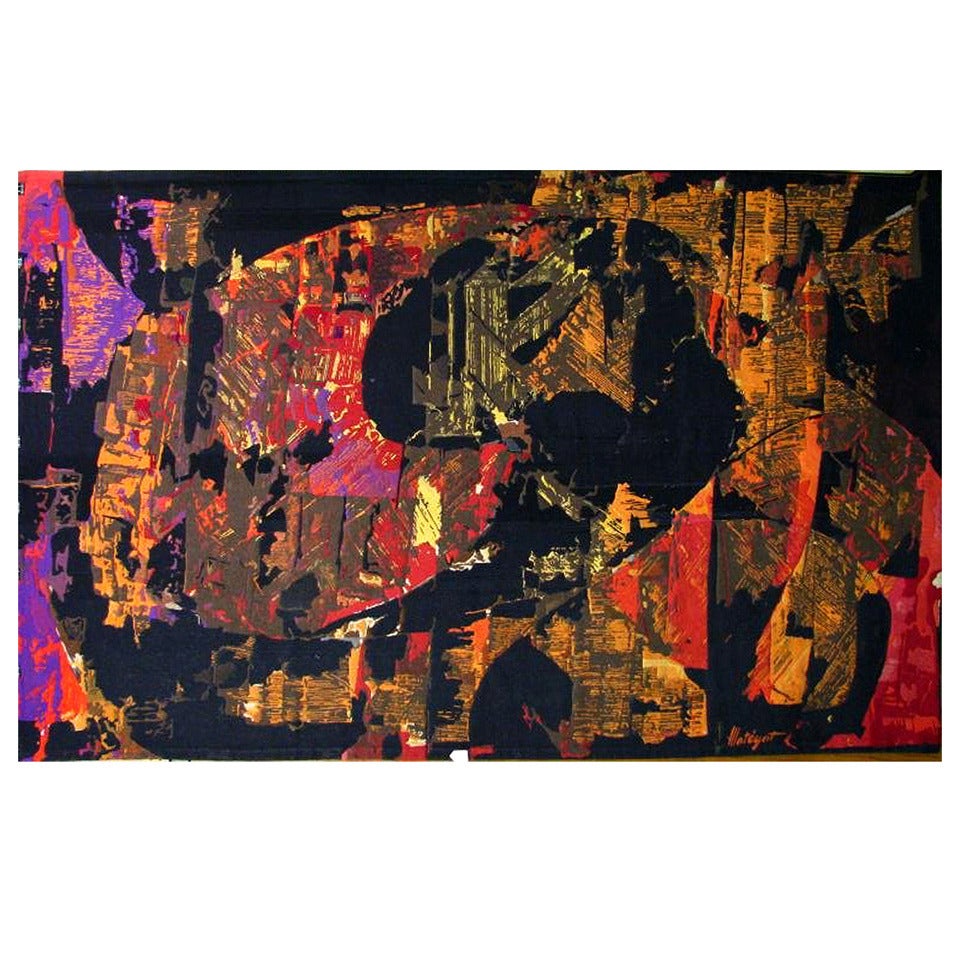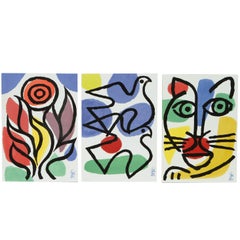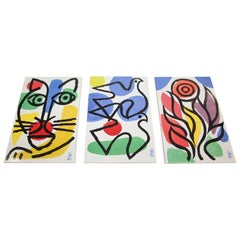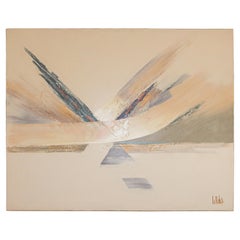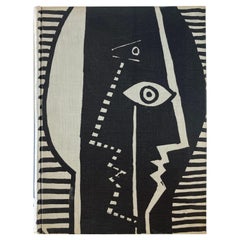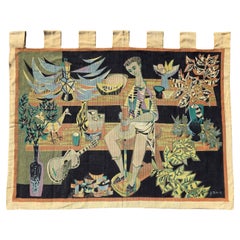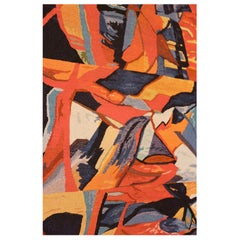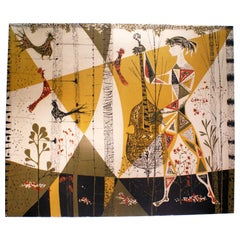Items Similar to French Cubist Art Tapestry Title " Musique Tropicale" by St Epin Paris France
Video Loading
Want more images or videos?
Request additional images or videos from the seller
1 of 22
French Cubist Art Tapestry Title " Musique Tropicale" by St Epin Paris France
$2,950
£2,240
€2,561.61
CA$4,121.58
A$4,584.09
CHF 2,393.67
MX$55,783.55
NOK 30,570.84
SEK 28,670.05
DKK 19,118.30
Shipping
Retrieving quote...The 1stDibs Promise:
Authenticity Guarantee,
Money-Back Guarantee,
24-Hour Cancellation
About the Item
French Cubist Art Tapestry Needlepoint, Title " Musique Tropicale" Tropical Music by St Epin Paris Tapestries.
Inspired by the work of kandinski, Picasso, Braque, Fernand Leger, and more French cubist and fauvisme artist.
Handcrafted in a kaleidoscopic array of bright colors, tangerine, emerald green, yellow, purple, deep sky blue and black.
This Cubist vintage needlework depicts some musical instrument, a luth, a guitar, some drums, surrounded by a a shiny sun and gold decor in a vivid palette and cubism style.
Mid century wall hanging crafted in a needlepoint technique.
The artist is unknown, this artwork tapestry is not framed.
Marked in the back. St Epin Paris, Musique Tropicale, Made in France.
Circa 1960-70's. Great Condition, Never been used, well stored.
Great to add colors to any Modern or tradional decor, for the Music and Modern Art Lover.
Dimensions: 73 inches x 46 inches.
- Dimensions:Height: 46 in (116.84 cm)Width: 73 in (185.42 cm)Depth: 0.25 in (6.35 mm)
- Style:Post-Modern (In the Style Of)
- Materials and Techniques:
- Place of Origin:
- Period:
- Date of Manufacture:1960
- Condition:
- Seller Location:North Hollywood, CA
- Reference Number:Seller: FTP1231stDibs: LU906832086622
About the Seller
5.0
Platinum Seller
Premium sellers with a 4.7+ rating and 24-hour response times
1stDibs seller since 2011
3,059 sales on 1stDibs
Typical response time: 1 hour
- ShippingRetrieving quote...Shipping from: North Hollywood, CA
- Return Policy
Authenticity Guarantee
In the unlikely event there’s an issue with an item’s authenticity, contact us within 1 year for a full refund. DetailsMoney-Back Guarantee
If your item is not as described, is damaged in transit, or does not arrive, contact us within 7 days for a full refund. Details24-Hour Cancellation
You have a 24-hour grace period in which to reconsider your purchase, with no questions asked.Vetted Professional Sellers
Our world-class sellers must adhere to strict standards for service and quality, maintaining the integrity of our listings.Price-Match Guarantee
If you find that a seller listed the same item for a lower price elsewhere, we’ll match it.Trusted Global Delivery
Our best-in-class carrier network provides specialized shipping options worldwide, including custom delivery.More From This Seller
View AllPost Modern Celestino Piatti Ceramic Art Tiles in Picasso Style
Located in North Hollywood, CA
Set of three, fire, wind, earth, original post modern ceramic tiles by Celestino Piatti.
Celestino Piatti (1922-2007) was a Swiss graphic artist designer, painter and book illustrato...
Category
Late 20th Century Swiss Post-Modern Contemporary Art
Materials
Ceramic
Celestino Piatti Ceramic Art Tiles in Picasso Style Post Modern
By Pablo Picasso, Celestino Piatti, Joan Miró
Located in North Hollywood, CA
Set of three, fire, wind, earth, original post modern ceramic tiles by Celestino Piatti.
Celestino Piatti (1922 – 2007) –
A set of Three 1980s ceramic tiles from the series Earth,...
Category
Late 20th Century Swiss Post-Modern Contemporary Art
Materials
Ceramic
Vintage Signed Lee Reynolds Studio Textured Abstract Painting
By Lee Reynolds, Vanguard Studios
Located in North Hollywood, CA
Vintage Lee Reynolds, Vanguard Studios original signed textured abstract oil painting.
Large Lee Reynolds abstract oil painting by Vanguard Studios.
Gorgeous large-scale Lee Reynolds abstract painting, Mid-Century Modern.
A vintage abstract painting composed of angled brush strokes in white, beige, blue, orange hues in varying intensities.
The piece is signed Lee Reynolds in the lower right corner and is a production of his well known Vanguard Studios.
Measures: Height: 48 inches; width: 60 inches.
Circa 1960s.
Lee Reynolds
Lee Reynolds Burr (1936–2017) opened his Vanguard Studios in Beverly Hills, California, in 1964 to make oil paintings an attainable decoration for any American household. With seascapes, nautical scenes, still lifes, bullfights, cowboys, pastoral views, hot-air balloons, horse races and abstractions, there was a Vanguard Studios creation to match any taste and interior.
Born in Los Angeles, Burr studied art at the University of Southern California. After graduating and a stint in the U.S. Army, he worked in a local studio as a painter before becoming a home decor entrepreneur with financial support from his mother.
Only a fraction of the alleged hundreds of thousands of oil paintings produced by Vanguard were actually painted by Burr, even though they were signed “Lee Reynolds,” “Lee Burr...
Category
20th Century American Mid-Century Modern Paintings
Materials
Canvas
$1,584 Sale Price
20% Off
Wilhelm Boeck and Jaime Sabartes, "Picasso" 1955
Located in North Hollywood, CA
Vintage, 1955, first edition, Picasso, S.P.A.D.E.M. Paris, Boeck and Sabartes,
Vintage, Picasso, First Edition, 1955.
Description: Pablo Picasso. Wilhelm Boeck and Jaime Sabartes.
Pu...
Category
20th Century Spanish Modern Books
Materials
Paper
Antique Moroccan Moorish Silk Textile Tapestry Wall Hanging Hiti 19th C.
Located in North Hollywood, CA
Antique Moroccan Moorish Silk Textile Tapestry Wall Hanging Hiti Ottoman voided silk velvet wall covering.
Silk velvet cut designs, light browns, yellow, cream and blue, the panel consist of two Moorish arches with Islamic floral designs.
Antique textiles from early late 19th century.
Each arch panel is 63" height X 26"5 wide
Antique silk tapestry...
Category
Antique 19th Century Moroccan Moorish Tapestries
Materials
Silk, Velvet
Persian Kalamkar Hand-Blocked Tapestry Textile Isfahan
Located in North Hollywood, CA
An absolutely gorgeous example of the traditional Antique Persian hand-blocked tapestry textile.
Persian Kalamkar (Qalamkar or Ghalamkar) woodblock print textile is from the great ci...
Category
Early 20th Century Asian Islamic Textiles
Materials
Linen
You May Also Like
773 - Tapestry M.C.Bertrand of the 20th Century
By Royal Manufacture of Aubusson
Located in Paris, FR
Modern tapestry of the 20th century realized by M.C.Bertrand, in perfect condition of conservation.
Negotiable price and free delivery.
Dimension: 175 cm x 100 cm.
Category
Vintage 1970s French Mid-Century Modern Tapestries
Materials
Wool
Mid-Century French Textile Wall Hanging Design by Robert Debiève
By Roger Debievres
Located in Antwerp, BE
This striking mid-century French wall hanging is a printed textile artwork designed by renowned French artist Robert Debiève. Known for his vibrant, playful compositions, Debiève’s...
Category
Mid-20th Century French Mid-Century Modern Tapestries
Materials
Fabric
Vintage French Tapestry by Georgette Owens. Size: 3 ft x 4 ft 10 in
By Georgette Owens
Located in New York, NY
Vintage French Tapestry by Georgette Owens, France, Mid-Twentieth Century. Size: 3 ft x 4 ft 10 in (0.91 m x 1.47 m)
Category
20th Century French Mid-Century Modern Tapestries
Materials
Wool
“Allégorie en Musique” Figurative Tapestry Signed “René Fumeron”
By Rene Fumeron
Located in Beirut, LB
Beautiful decorative vintage tapestry signed by René Fumeron.
Entitled “Allégorie en musique”. The tapestry exhibits subtle imperfections in certain areas...
Category
Mid-20th Century French Art Deco Tapestries
Materials
Canvas
A Large Modernist Abstract Tapestry by Mathieu Mategot
By Mathieu Matégot
Located in Atlanta, GA
A modernist wool woven tapestry designed by French artist and designer Mathieu Mategot (1910-2001) circa 1960s. The piece is signed with Matégot and monogrammed TMP fino (Manufactur...
Category
Vintage 1960s Portuguese Mid-Century Modern Tapestries
Materials
Canvas, Wool
A MID-CENTURY-MODERN Handmade & Signed ABSTRACT TAPESTRY, AUBUSSON, France 1950
Located in PARIS, FR
An exceptional handmade signed modern Aubusson tapestry, Modernist, Forme-Libre, Lyrical Abstraction, made in thick wool hand woven, depicting an abstract yet floral, organic motif...
Category
Vintage 1950s French Mid-Century Modern Tapestries
Materials
Wool
More Ways To Browse
Leger Tapestry
Fernand Leger Tapestry
Picasso Needlepoint Tapestry
Picasso Needlepoint
Lurcat Rooster
Paul Mccobb Plant Stand
Vintage Grape Crusher
West African Tapestry
William Morris Tapestry
16th Century Tapestry Fragments
Antique Portiere
Arras Tapestry
Aubusson Cherubs
Aubusson Portiere
Embroidery Chinese Wall Hanging
Oudenaarde Tapestry
Verdure Tapestry Fragment
Victor Vasarely Tapestry
